Monday, October 29 2007
One of the things I've both loved and hated about animation is trying to describe it in terms familiar to American TV viewers. I love it because it's a constant reminder of what I like about anime in the first place: it's different. While a lot of anime seems to build off of other anime in terms of genres and conventions, it's still not to difficult to find something unusual yet still fascinating. I hate it, of course, because I then have difficulty explaining to anyone outside that little circle exactly what it is I'm watching.
Aria is especially difficult to describe. It's science-fiction, although the science-fiction is merely detail, and if you're looking for a science-fiction show, this almost certainly isn't what you expected. It's got its fair share of lighthearted comedy. It's got some fantasy hidden here and there. Above all, it's a slice of life story (if you can call it a story). It's not what I thought I would enjoy. It's got no real plot, although the episodes are sequential and often build off of one another; it's essentially 40 filler episodes. It's got no real action; almost all the drama is of the relationship kind. Aria is a story of the day to day life of three young women who are apprentice tour guides in a rebuilt city of Venice on a terraformed Mars that's now 90% water, and what the series has is character development, often low key, but still character development.
One of my pet peeves about anime and TV in general is character development. I like to see characters and relationships progress over time. Be it in relationships or combat, the characters must learn and experience and grow to be fully human. A lot of anime, including some classics, loses this key point. The cast of Ranma 1/2 will always be stuck in the same complicated web of relationships. It's somewhat futile to watch them, as we're back to the same relationship status quo as we were at the beginning of the series. Sgt. Sousuke Sagara will always be a military blockhead cluelessly circling Kaname. Tenchi Masaki is eternally stuck between his harem of suitors.
The other thing Aria has going for it is that the world of Aqua and the city of Neo-Venezia are fully fleshed out. In part, it's because it's a tranquil setting done at a slow pace, and the animators can afford to use a still background for most of the image. But still, the animators have found the time to include unique locations in just about every episode, and the seasonal effects in some of the episodes are well done (though there are about two fall episodes in the 40 total). With the extra detail added to Aria the OVA: Arietta, it is an absolute delight to watch. There's enough color to draw the eye in general terms and enough detail that it's impossible to take in the detail in each shot.
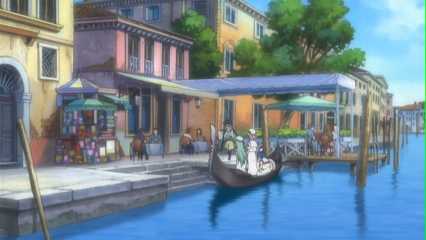

One of the things that always got me about playing a computer game, especially some of the more recent ones, is seeing the same environments reused over and over. It's another abandoned warehouse with stacks of boxes and barrels. It's another wrecked castle. It's another power station with mysterious tubes of lava. What was worse was pencil and paper RPG GMs that insisted on reusing the exact same tropes over and over again; with a pencil and paper RPG, the art budget is limitless. Animation has a fixed budget, and I know certain studios have a habit of overspending, but some animation studios frequently miss opportunities to make their worlds come alive.
Further thoughts about character development below the break. Some spoilers about character backstory, if you can consider anything in this series to be important enough to be kept secret.
more...
Posted by: Civilis at
08: 04 PM
| Comments (4)
| Add Comment
Post contains 1374 words, total size 10 kb.
Thursday, October 04 2007
Dan at Protein Wisdom provokes a blog firestorm by using an offensive slang term to highlight the complete lack of real world perspective of many on the left. Shamus Young, artist behind the wildly awesome DM of the Rings comic, hasn't gone through a dozen strips on his new comic, Chainmail Bikini, before starting a riot in his audience (details here). I haven't dared to try the link, but regular Ace of Spades commenter Zombietime has covered (Warning! Very Definitely Not Safe For Work!) an "Alternative Lifestyles" fair in San Fransisco that seems likely to provoke the equally offensive Fred Phelps crowd into their own peculiar brand of offensiveness. Political commentators on all sides have gone out of their way to be as rude and boorish as possible towards the other side of the politico-cultural spectrum.

I think that in part this modern explosion of offensiveness and counter-offensiveness is a side effect of the fracturing of modern American culture and a nasty side effect of the culture wars, and as such a part of the Big Picture in that it ties culture, identity and politics together to make us what we are.
My observation has been that the advent of modern technology has led modern culture in America to be increasingly fractured as we have much less in common with our neighbors and our fellow Americans than in the past, and that separation is increasing as time and culture pass. This is in many ways both a positive and negative development.
I believe that part of the reason behind the explosion of offensive behavior is that increasingly almost everyone feels like an outcast from American culture. In part, it's an expression of our snobbishness; "we're not like the others, the common, the strange, the rich, the poor, the conservative, the liberal. We're better than the others. Our way is right. If only they could see that we're right, they'd agree with us, but they're stupid and evil. We don't care what they think."
It's behind the offensive costumes at Otakon. All otaku (anime geeks) are definitely perceived as weird by the rest of society. I watch the looks cosplaying con goers get from normal passers by. Seeing someone running around downtown Baltimore in weird clothes and blue hair carrying a six foot wooden and PVC sword is definitely strange. And if they are going to look at you strange anyways, whats the difference between that and wearing a Nazi armband? Nothing, if you're one of those morons that knows little of history. You and I know the difference, but your average rebellious high schooler may say, "The powers that be don't like me. The powers that be don't like Nazis. Therefore, to rebel against the powers that be, I'll side with the Nazis." And in doing so, they're more ostracized and pushed towards other things that are ostracized.
It's also aggravated by the fact that the modern cult of victimhood has made all victims equal, and therefore all victimizers equal. "Sure, Hitler and Stalin were bad. But so was Columbus. Therefore people that celebrate Columbus Day are as bad as Nazis, and I don't care if I offend them. Also, they offend me just like Nazis do."
To sum up, since we're going to offend someone anyways, we don't worry about how offensive our speech or behavior is. Since we view everyone else as offensive, we don't care if we offend them.
Posted by: Civilis at
08: 50 PM
| No Comments
| Add Comment
Post contains 635 words, total size 4 kb.
Tuesday, September 25 2007
The big controversy in the mainstream media is the protests by Hispanic groups angry that there was no special attention paid to Hispanic veterans. Burns has added some additional footage to address this, but it seems to be regarded as too little, too late. This is a entertaining side-effect of the way the second world war is studied in American schools, which pretty much defines how most Americans look at the history of the war. Approximately 95% of the study of the history of the second world war through high school is devoted to five topics:
1. Hitler's rise to power, attributed to the harsh Treaty of Versailles.
2. The Holocaust.
3. The internment of Japanese-American citizens.
4. The home front and the changing cultural demographics of America, with emphasis on the role of women and the continuing discrimination against minorities.
5. The morality of the decision to use the atomic bomb.
As "The War" is dedicated to the American experience, numbers one and two are justifiably given brief mention. The series hasn't progressed enough to get to number five, which, given the secrecy involved, might not be covered much at all. The remaining two then become a never-ending grudge match to make sure each ethnic group gets its fair share of coverage. The coverage of the internment of Japanese-Americans has drawn some fire from conservative commentators, and it does have a large role in the story, but I think it can be justified on the grounds that it is a unique blemish on American history, and one that justifies a specific debate. But American history as taught in school has become by and large a story of ethnic groups and their contributions have been measured as group members. As such, the debate by particular groups trying to grab their share of the story is only natural.
Given that, the fact that "The War" does manage to cover the war itself is something of a miracle. It gives short shrift to many of the individual battles, preferring to cover the war from a soldier's perspective of constant war. As such, the narration is rather general and non-technical, and tends to drift towards personal experiences, augmented by interviews with veterans. The footage, on the other hand, is spectacular, especially to someone used to history channel documentaries. The series includes lots of combat footage, including the sometimes bloody aftermath. It also includes lots of footage from Axis records. To someone who already knows the military history, the series doesn't say anything new, but what it shows is stuff I've never seen, especially the footage of the ground combat. As I write this, the series is covering Anzio, and there's good footage of 105mm howitzers, M10 tank destroyers, and a wrecked Panzer IV, probably a IV H (it's got the long 75mm gun).
The news coverage of the series premiere on Sunday in the Washington Post was heavy with political overtones, which led to one fascinating example of cognitive dissonance. In an article on the series in the Sunday Style & Arts section of the post, Rick Atkinson writes "Perhaps it's too tempting to contrast the meritorious struggle of the 1940s with the dubious conflict today." There is a valid debate of the effectiveness of the current war in Iraq and the merits of the strategy and tactics and or the war itself. But describing the motives behind the current war as dubious sounds a bit hollow when just a few sentences before is this: "Yet a strong case can be made against necessity. Had the future allied powers intervened to thwart Hitler earlier in his maniacal trajectory, perhaps the calamity could have been avoided."
Posted by: Civilis at
08: 49 PM
| No Comments
| Add Comment
Post contains 658 words, total size 4 kb.
Sunday, September 09 2007
The people at Battlefront Miniatures that produce Flames of War had divided up World War II into three distinct periods for the purposes for army construction. Early war is 1939 - 1941, mid-war is 1942 - 1943, and late war is 1944 - 1945. They have recently revised the rules into a second edition, and started with the mid-war time period for releasing army lists, and have since expanded into late war. First edition never had official published lists for early war, but lists were released online and removed when second edition was released. So when this month's Sunday battle was announced as Early War Eastern Front, I was doubly screwed: I have no early war specific units, no army lists, and I'd only started on Eastern Front forces in general about a month and a half ago, so I had to form my list at the store from Afrika Korps forces and loaner equipment from my German allies.
The scenario itself was interesting as well. The board was 5 feet wide by 15 feet long. It was divided in half length-wise by a river, spanned by two bridges. It was then filled with assorted hills and woods, and a road and two villages were positioned along one of the long edges. The two Soviet players set up on the middle third of the field length-wise, and were told to divide their forces across both sides of the river. I, with one company of German armor, was the main line of advance, and was set up along one of the five foot edges of the board. The soviets objectives were to destroy German units and to advance what they could off the board on the far five-foot edge from me. The complication was that two other German players would be advancing from the sides of the third of the board between the Soviet players and their exit edge, with the idea of closing a pincer on the Soviet forces. The Soviets also had a time limit of ten turns before there was a chance every turn that the pincer would close completely; any remaining Soviet units were considered lost. The picture below shows most of the battlefield; toward the camera is the Soviet middle third with the river. The far edge along the wall is the Soviet escape edge.
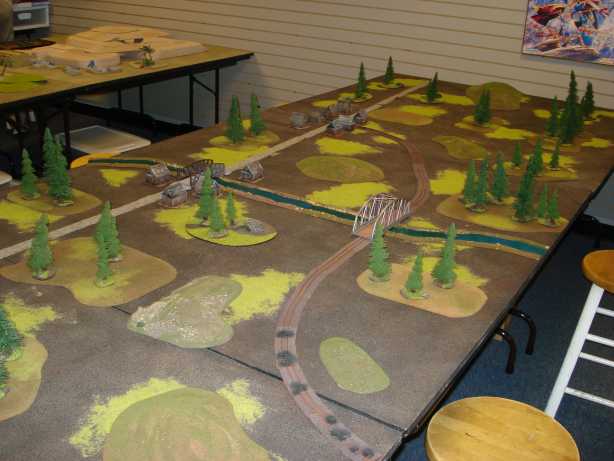
The Soviets deployed two anti-tank units, two infantry units, and a tank unit equipped with fast BT-7 tanks on my side of the river. They deployed an artillery battery and five armored units on the far side of the river, three with BT-7s, one with heavy T-26s, and one with armored cars. I deployed my forces back along the road. The Soviet tanks on the far side of the river immediately began to advance towards the rear and safety, while the AT guns prepared to make a last stand to cover the tanks and infantry as they jammed the bridges. Below are my forces as they approach the AT guns on the left side of the board.
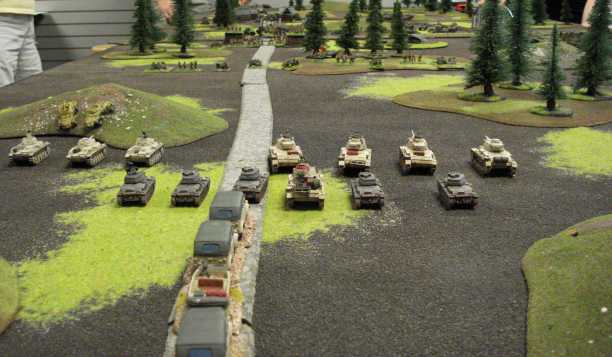
I concentrated my entire force along the road, figuring that I could both amass my firepower on one set of guns and destroy it faster and that any bypassed guns would still count as destroyed when the encirclement fully closed. You can see the mixed nature of my forces. Four of the incredibly fearsome and deadly (by early-war standards) Panzer III auf H in Afrika Korps colors are on the right. Behind them are five Panzer 38(t) tanks in German gray, with my company CO in a very stowage-overloaded PzIIIH. Along the road are trucks carrying a full platoon of Pioniers. Along the left are three Panzer II auf F light tanks and two Sd Kfz 222 armored cars. In front of them are visible six Soviet 47mm anti-tank guns, just out of range. I then closed with and engaged the guns with my entire force. The first results are shown below.

Four of the six AT guns destroyed. The unit is pinned down, and even some 'persuasion' from the commissar is unable to rally them before they are wiped out on the next game turn, and my forces regroup before the next set of Soviet troops. Meanwhile, all the Soviet tanks have crossed the river, and a fierce tank battle is engaged further down the road, leaving a number of destroyed tanks for both sides. The German forces attacking along the road have deployed a screen of Pz38s protecting a pair of 76mm AT guns and a massive 88mm AA gun, sighted right down the road. Along the other side, the German Pz38s are hitting and running from the forest, and the lighter Soviet tanks are hiding behind the hills rather than advancing. The Soviet infantry, meanwhile, is jammed trying to withdraw across the river. The infantry unit along the road bridge left a doomed rearguard of troops in the village on my side of the river to stop my advance from rushing across the bridge, while the other bridge is covered by the surviving AT battery. The Soviet artillery, meanwhile, is dug in on the far side of the river where it can cover both bridges, and the Soviet 76mm artillery makes an impressive anti-tank gun. The overall situation is as shown below.

Across the river, the fighting was fearsome. The Soviet forces sustained heavy losses as they pushed towards freedom, but one of the Soviet players unwisely retained a rearguard of tanks on the hill behind their artillery, and left some of their armor unengaged in the middle of the field. In the photo below, you can see the flames of the burning Soviet and German armor in the distance.

In order to have some effect on the battle and keep the Soviets attention divided, I needed to attack, and ideally take out the artillery battery. To do this quickly, my Pz38s needed to risk the Soviet AT battery, but I threw everything I had into the fight, with the Pz III's closing as well against the only guns on the Soviet side easily capable of taking one out with a front shot, as shown below.

Close behind the armor were the now-dismounted Pioniers, with the armored cars and the PzIIs raking the Soviet infantry in the buildings blocking the bridge. The Pz38s succumbed to the combined fire of the AT gun platoon, artillery battery, and the tanks on the hill behind, and one round from the artillery hit home on a PzIII, blowing it up. But the results were worth it, as shown below.
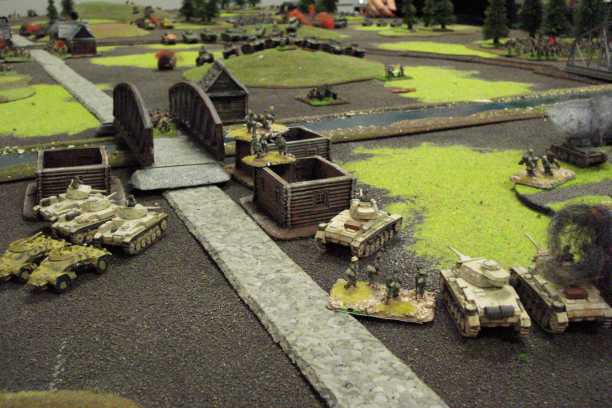
The artillery battery is down to one gun (which dies shortly thereafter), and the buildings are clear of Soviet troops (one surviving group flees across the bridge), with light casualties to the attacking Pioniers. The building on the left was incidentally cleared by the PzIIs basically running into the building, and it was quite lucky that one didn't end up stuck in the wall. On a shot of the right you can see the remains of the valiant Pz38s (the two not destroyed retreated off the field) and the slowly advancing Soviet AT gun battery.
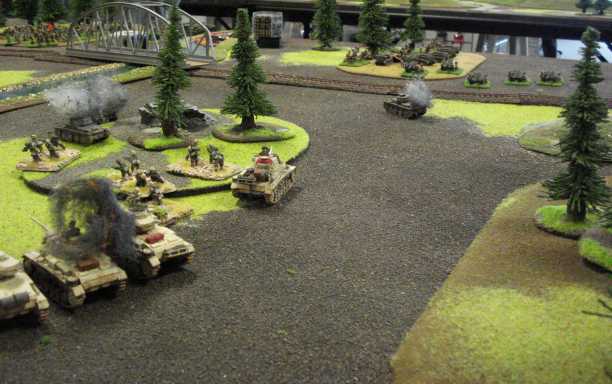
My forces cross the bridge, mopping up the stragglers, while the surviving Soviet armor circles the wagons between my forces and the surviving tanks of the pincers, one of which is largely untouched. At this point, the game is called. Overall, a German victory. We lost four complete units, my Pz38s and a tank platoon, an armored car platoon and a Pionier platoon belonging to the pincer that came from the road edge. Three Soviet tank units, the armored cars, an AT battery, and an artillery battery were already wiped out, with the rest of their forces unlikely to survive. One Soviet tank made it off the board to report the loss (not enough to score), and the commander was promptly shot for desertion.
A fun game, overall. The Soviets were hampered by bad luck and hesitation to engage the German pincers en masse. I probably should have been more careful with my Pz38s, but by keeping the one Soviet tank platoon engaging them, they probably kept the Soviets from mounting a unified defense where it would have done some good.
Posted by: Civilis at
08: 07 PM
| No Comments
| Add Comment
Post contains 1442 words, total size 9 kb.
Thursday, August 30 2007
Wednesday, fired up the computer and went to Shamus Young's excellent site. And what awaited me there? The game I had just gotten addicted to is loaded with more DRM than I can shake a stick at. It has truly insane system requirements and doesn't even work on some systems that meet those requirements. And server overload means that most people who purchased the game can't even play it. <Sigh>
Well, it works on my system, it installed just fine, and I was stuck with the game and the damn DRM. So I may as well play it. And it is a fun game. Not great enough to be legendary (but then again, I'm noticeably picky) but probably the best story-driven FPS I'd ever played.
What's not to like?
The DRM. The DRM. The DRM. The System Requirements from Hell. The DRM. (You get the idea.) It takes a long time to load each level, so it doesn't hurt to have some reading material. The game itself is relatively short; it's about 10-15 hours. Most of the weapons seem astoundingly inaccurate at long range, so no real sniping here (as I love sniping in FPS games, this was a disappointment). The plot had a fair amount of cliche FPS elements scattered about. The 'moral choices' bit was overplayed, as there's basically one thing you do that offers you a moral choice, and it's not particularly expensive to take the right choice (Dark Forces II offered a much more diverse moral choices in a FPS). The moralizing is a bit heavy-handed at first. The enemies got a bit repetitive after a while. The DRM. The DRM. The... (just a reminder)
What's to like?
The world itself is beautiful, and Rapture is a fantastically realized landscape. Each level had a completely different feel, with at least new "wow" moment looking around at the world, and most were not the usual FPS fare. The plot has its share of twists and turns, and when the big twist hit, it had an effect. The game designers used various messages left scattered around to tell the story and give sometimes tantalizing hints as to what the big story was, and they pulled it of perfectly. The variety of powers available gave me many different approaches to combat, and I spent a lot of time wondering if I could have done things a better way. The surprise factor was enough to keep things interesting but not enough to give me the shakes. Amazingly enough, the game played without a noticeable bug or graphic hiccup; I've seen a fair amount of games get good, only to have a show-stopping bug halfway through.
I'll post a more thorough, spoiler-filled analysis below the fold this weekend (hopefully).
Posted by: Civilis at
08: 54 PM
| No Comments
| Add Comment
Post contains 559 words, total size 3 kb.
Thursday, August 16 2007
Lately, one group of turtles has taken to floating on the surface of the water, diving to the bottom of the pond when they sense a human. They'll also dive to the bottom when a goose or duck approaches, but only at just about the moment of collision. It almost seems like the geese are hunting the turtles, so it plays out as a mini Battle of the Atlantic. I've watched as a turtle wolfpack lies sunning itself in the pond, to be startled and forced to dive deep to avoid the furious avian ASW onslaught. Normally the battle lasts for a few minutes before the birds steam off for less elusive prey, and the turtles resume their restful watch on the surface.

The pond in question is low due to lack of rain here in Northern Virginia, so their usual favorite resting places, the drainage grates, are out of reach, but there is one floating board that makes a handy dry resting place.

This turtle has a substantial gouge in its shell.

Posted by: Civilis at
08: 52 PM
| No Comments
| Add Comment
Post contains 187 words, total size 2 kb.
Tuesday, July 31 2007
I came to a different conclusion about what I believe was going on behind one of the mysteries of Shingu's plot, but that's my perogative as a viewer, and his explanation both fits the facts and satisfies the characterizations. As a warning: this post contains minor spoilers including brief synopsis of the major plot and characters, about the following series: Shingu: Secret of the Stellar Wars, Ranma 1/2, Irresponsible Captain Tylor, Ah! My Goddess. The More section below the fold has my plot analysis of Shingu: Secret of the Stellar Wars, including major spoilers of crucial plot elements.
I have been thinking about the role of luck in plot for both anime and role-playing games. This is separate from probability in games, even fluke probability. While I have had interesting thoughts on the role of probability in gaming, there's a big difference in luck as a role in plot and the role of probability in action. To keep the discussion focused on luck in plot, we'll start with a look at anime, a non-interactive medium.
To start with, luck as a role in plot is specifically not a random factor. The anime writers and director have to plan in advance what happens to his characters in order to drive the story. Anything that happens has to be specifically written to happen, so there's no real chance involved from the perspective of the writer or viewer. I am instead talking about luck from the character's perspective inside the imaginary world created by the writer.
My belief is that in anime, crucial plot elements should not be explained by a factor of random chance. There should be a deliberate action by the main characters or by the series antagonists driving major plot points. The main characters have to be responsible for what they do. If the bad guy needs to be stopped, he needs to be defeated by a good guy or by himself. There's no satisfaction to places where the bad guy is defeated by circumstances under which neither he nor the main characters have any control. Likewise, if something seriously bad happens to the main character, it has to be caused either by enemy action or the heroes own hubris for it to have emotional effect. If it's enemy action, it's time for the hero to affirm his dedication to overcoming the enemy. If it's hubris, the hero needs to overcome his own shortcomings before he can truly move on.
There is an exception, and that is characters that are specifically defined by the plot as lucky or unlucky, even if this status is never vocalized. As an anime example, Irresponsible Captain Justy Tylor is lucky; in fact, he's lucky to the point where his luck can be reasonably counted on to get him out of a jam and get the crew of his ship, the Soyokaze, through problems if they are acting on his behalf. At this point with the plot, improbable events that benefit Tylor or the Soyokaze can be justified in plot with relation to Tylor's luck. The luck is Tylor's, so the sense is that Tylor defeated the problem, even if he didn't do it consciously.
Likewise, Ranma Santome from Ranma 1/2 has a very specific case of bad luck due to his curse: when he gets splashed with cold water, he turns into a girl. How often do random people get splashed with cold water on a daily basis? Not often. Yet it happens to Ranma all the time. It's acceptable in plot for this to happen because of the curse's unstated component, namely that it's not a proper curse unless it seriously inconveniences the one cursed.
In a sense, the System Force that protects Belldandy and Keiichi in Ah! My Goddess is luck given an explanation as to why it's not a product of chance. Keiichi wished that he could have a goddess like Belldandy at his side at all times, and the System Force is the computer-like universal system's way of keeping that wish by basically stopping anything that looks to interfere with that wish in the most direct route. To mere mortals, however, it just looks that whenever someone tries to separate the two, something unlucky happens to that person. To someone in the Ah! My Goddess universe that's not familiar with the real ways of the universe, it is luck or chance as there is no consistent explanation of what's going on, but Goddesses and readers are privy to the mechanism that makes these events products of deliberate action (even if the events themselves are semi-random). (It brings to mind another, more recent, series involving a "god" with the ability to distort reality to her whims in a subconscious fashion.)
Which brings us to conspiracy anime such as Shingu. One of the hallmarks of a good conspiracy plotline is a series of seemingly random events that all come together to form one coherent plot. Ideally, anything attributable to luck should be able to be explained away as deliberate action by one of the conspiracies by the end of the story (or at least hint at another, greater conspiracy just beyond the reach of the story). Shingu accomplishes this very well. Although there are a number of questions left deliberately unanswered, including one big question, the sense is that nothing has happened purely by luck.
Applying these lessons to games, especially the more plot or story focused roleplaying games, is hard, because no one has complete control of the plot and you have a truly random element thrown in in the form of dice or other random number generators. You have at least the GM, running the story as one faction with the party of players running the second faction. In more complicated games, the GM is trying to script the actions of two or more independent factions such that each has a coherent motivation and plan, while the players are each a separately motivated faction. Ironically enough, most of the rule-based roleplaying games put down on paper the difference between plot luck, which is a rule, and random chance, the rolls of the dice. Most rule systems have a way to designate characters as lucky or unlucky, subject to luck in the imaginary world of the game which takes the forms of rules in the real world of the players.
When plotting a roleplaying game as GM, I tend to rely on luck only in the here and now of the characters. Any actions outside the direct view of the players are scripted for the most rational actions of each faction I control. The only random chance that can affect this script is direct action by the players. On the other hand, the factions I control have to act as if there was luck involved in their actions. It's a tough balance to work.
more...
Posted by: Civilis at
08: 25 PM
| Comments (6)
| Add Comment
Post contains 1756 words, total size 11 kb.
Sunday, July 22 2007
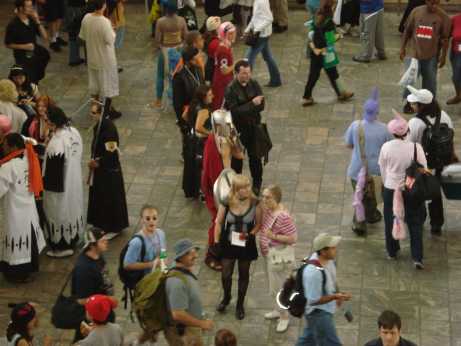
What does one do at an anime convention? Oddly enough, the one thing I didn't do this year is actually watch any anime. I was with a friend with more refined tastes, and there was nothing we could agree on watching which was more interesting than watching our fellow otaku. We therefore spent a lot of time people-watching and taking photographs. My friend is a much more skilled photographer, and his photos are up on his flickr page. We did catch the anime music videos, of which there were no particularly outstanding examples this year. We also spent some time in the dealer room, acquiring swag, and in the game room, watching people playing video games (and occasionally joining in ourselves.)
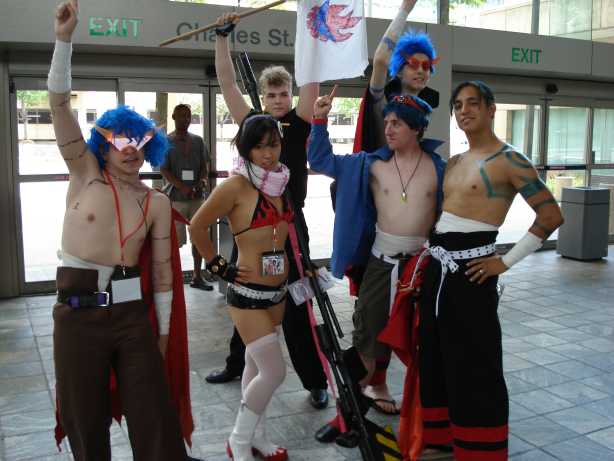
I can often get a sense of the state of the otaku community by watching the cosplayers at the convention. As always, Bleach, Fullmetal Alchemist and Naruto are heavily represented. For a new series, Tengen Toppa Gurren Lagann (above) had a surprising following. Fate/Stay Night has come in to its own with a sizable representation. There were more members of SOS-Dan from Melancholy of Haruhi Suzumiya than last year, but that club was overshadowed by the Ouran High School Host Club (below).
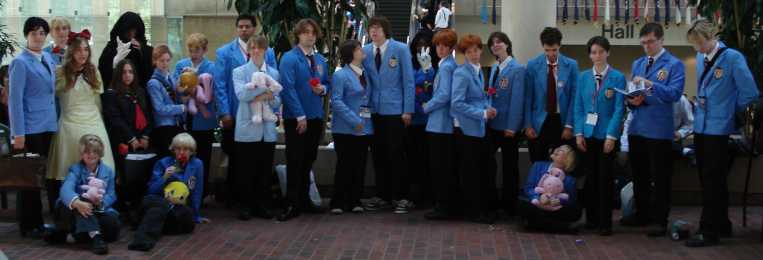
Some series always have a presence, and are fairly consistent from year to year: Sailor Moon, Utena, Inu Yasha, Fruits Basket, Prince of Tennis, and Hellsing. DBZ representation was down, as was Evangelion, although I still saw a Gendo or two, a Rei, and at least one Asuka. Gundam was down, although there were more of the old school Gundam characters.
As there is a cross-interest between anime and video games, especially Japanese video games, video games were well represented amongst the cosplayers. The Final Fantasy and Kingdom Hearts series are heavily represented. A lot of the fighting games have representatives as well, especially the Dead or Alive series, the Guilty Gear series, and the Soul Calibur series. There were a lot of very heavily armed generic mercenary types, many of which are probably connected to the Metal Gear series. Nippon Ichi's Disgaea (one of my favorite console games) had the usual couple of representatives. There were a fair number of Mario characters, with Princess Peach being the most predominant. Finally, none of the very plentiful Phoenix Wright characters ever objected to having their pictures taken (although most could be persuaded to object while having their picture taken (below).)
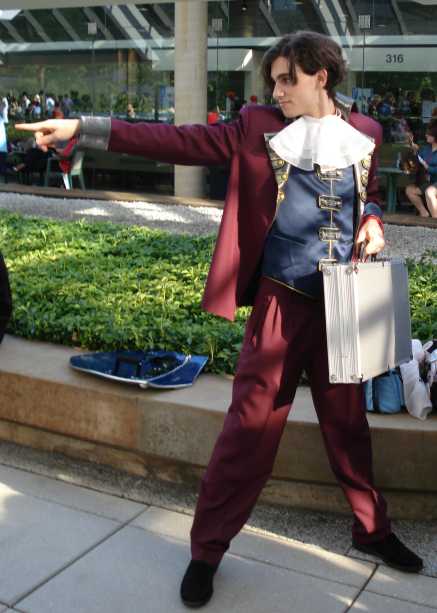
For American characters and generics, Jedi were out, Pirates were in, though Ninja still outnumbered Pirates thanks to their representations in specific anime series. American comic characters were out, with DC suffering more than Marvel from loss of representation. There were a few Transformers present.
[Warning: The next paragraph contains some disturbing imagery. People with strong imaginations should skip it. Don't say I didn't warn you.]
For the disturbing cosplayers, there were a few. One pimp had two 'ladies' on a chain. I didn't see Sailor Bubba or Man-Faye, but Man-noha was wrong, and the only thing more eye-gougingly awful than seeing a guy cosplaying Haruhi Suzumiya is seeing a guy cosplaying Haruhi Suzumiya in her bunny-girl outfit. Then again, you didn't need a costume to be disturbing. One guy had a pedobear t-shirt, and I'm told there was someone with a Nazi armband. People, you're not doing your hobby any favors. Grow up and stop trying to be offensive just to be offensive.
[Okay, rant and imagery over.]
Otakon is very heavily commercialized with regards to support from the American studios which release anime. Each company generally has a panel and a substantial booth in the dealer room, and Bandai, Geneon, and ADV had premieres. Still, Otakon had a fair number of fansubs on the schedule, including Code Geass, Sola, Nodame Cantible, and Lucky Star. This extends to products other than gaming; Mountain Dew had a promotion on Friday which was (apparently, as I only know about it third hand) offering free Dew or Dew merchandise to anyone who was willing to stand in line and play the Halo 3 demo.
The video game room is an interesting combination of Japan-only releases of games mixed with the latest in American console goodness. The Wii was represented with a number of party games, although the older Gamecube was in use more and on the bigger TVs for Super Smash Brothers and Mario Kart Double Dash. Boding ill for Sony, I didn't see anything that looked like a PS3 game, though there were a lot of PS2 games (with the consoles themselves locked away, it's hard to tell which console is which). Microsoft had a small but very visible presence for the X-Box 360 with an impressive four on four Gears of War game, and there was a smaller contingent of gamers playing Halo 2. In other gaming related news, it seemed that half the con had a Nintendo DS.
All in all, a fun convention.

Posted by: Civilis at
02: 10 PM
| Comments (3)
| Add Comment
Post contains 816 words, total size 8 kb.
Wednesday, July 18 2007
Posted by: Civilis at
09: 10 PM
| No Comments
| Add Comment
Post contains 22 words, total size 1 kb.
Sunday, July 15 2007
One of the first things I noted with regards to game development and game tactics and strategy when compared to historical scenarios is the role of what has come to be known as the "fog of war", the limited information available to a commander with regards to the current situation, be that situation real or simulated. The one thing that is obvious in retrospect when reading about the second world war is how little each side knew about the disposition and conditions of the opposing forces (and occasionally their own forces).
In tabletop gaming, its hard to represent the fog of war on a meaningful level without major investments in time and resources. Simple board games can accomplish this by hiding the values of the pieces from the opposing player, but still intelligence can be gleaned from watching what moves where, and where the opposing player is focusing his attention. More complicated games require a neutral party capable of determining when the opposing sides notice each other. This adds complexity and therefore time to the game, and requires the attention of an additional gamer that does not get the satisfaction of actually playing the game.
With computer games, the computer itself is able to act as a fair, transparent third party. This means that for casual gaming, the computer has an advantage over the traditional tabletop game as a means of providing a 'realistic' tactical model. The recent staple genres of computer games emphasizing tactical decision making have been the real-time strategy (RTS) and tactical first-person shooter (FPS) genres. Real-time strategy games generally emphasize an overall battlefield level of control, as the gamer directs units from an overhead perspective, and make decisions as to unit aquisition and overall strategy, while leaving the micromanagement of combat to the computer. First-person shooter games have always put the player in the role of a single battlefield unit, and emphasize reflexes and situational awareness. The modern tactical breed of FPS games adds the additional level of encouraging small groups of players to work together with a variety of roles in combat, where a balanced, coordinated team can effectively deal with larger numbers of uncoordinated opponents.
Real-time strategy games have almost always featured a two-level awareness limitation. First, the player screen normally shows only a small portion of the field and the units under the players control at a time, requiring the player to shift his attention between locations. Second, the information displayed is generally only valid for a short distance around the players units and their allies, meaning the current situation in a large portion of enemy controlled territory is unknown. On the other hand, units in RTS games are perfectly coordinated; what one unit can see is available to the player and any friendly unit. Additionally, units in RTS games also have perfect friend or foe recognition, and will not target friendly forces unless deliberately ordered to do so.
FPS games have a different set of issues approximating the fog of war. Normally, the player's visibility is the simulated line of sight from a single soldier or vehicle (although some games allow special extras, such as forward observation for beyond visual range artillery, remote sensors or camera-guided weaponry). As the limits of visibility in computer games is a factor of computer power and screen resolution, this visibility distance is very short and of poor detail at distance. Computer games tend to approximate this in some respects by providing a limited friend-or-foe system, but this tends to limit the realism of trying to identify a potential hostile. In addition, to provide the fun expected by people who want the fun of a fast-paced game with friends, FPS games normally provide the player with a running casualty tally, indicating the casualty, the killer, and the weapon, often valuable information.
Posted by: Civilis at
08: 59 PM
| Comments (2)
| Add Comment
Post contains 737 words, total size 5 kb.
Saturday, June 30 2007
I first heard about Shingu: Secret of the Stellar Wars from a posting on Chizumatic. Stephen Den Beste's review was positively glowing. Then, one by one, other anime bloggers picked up the series and all turned in highly positive reviews of a series I'd never heard of. Intrigued by both the reviews and the description of it as a conspiracy-filled sci-fi comedy, I picked it up and promptly got hooked myself.
The series, while not destined to become a classic, is one of the most fun series I've watched in a long time. I'm pleased to say that the reviews were correct. The plot varies smoothly between light-hearted and dramatic, the characters are likable and both drive and are changed by the plot. The animation quality is pretty good but not great, and the retro-style works very well with the series concept. Although a full-length series, this is likely to go into my stable of rainy-day anime.
Note: the following contains deliberately vague spoilers for series Shingu: Secret of the Stellar Wars.
Overall Rating: B+
Story: B+ The story has some minor issues that can be overlooked. I was pleasantly surprised that my plot sense was thrown off by some of the deliberate red herrings thrown in, but some of the events were cliche.
Main Characters: A The main characters are all likable once you get to know them, and they develop as the story progresses, and none of them turn out to fit well into any of the annoying cliche stereotypes.
Supporting Cast: A The supporting cast is very well done, with developed personalities. My biggest complaint is that a lot of the supporting cast doesn't get enough screen time.
Villain: C Given the amount of red herrings in the plot, getting to the final showdown takes a while with a couple of detours along the way, so its understandable that the showdown is a bit rushed, and occurs with little buildup.
Humor: A The series is enjoyably funny, and the humor by and large dervies from character interaction, rather than slapstick or sight gags (although there are occasional instances of both).
Action: C The series is a comedy, but it is a sci-fi comedy with a plot supposedly centered around fighting giant monsters from space, and the relatively quick and underwhelming action was a bit of a disappointment. A couple of the action scenes are quite good, though brief.
Drama: B- The series makes use of the conspiracy-filled plot to set up a fair amount of character drama between many of the characters. Some of the relationships seem forced at first, but by the end of the series the character interaction works very well.
OP and ED: D- The opening sequence is flat, and the ending is so plain as to be outright dull.
Fun Factor: A Between the likable characters, the outright twists in the plot, and the humor, this was an outright fun series to watch.
Posted by: Civilis at
02: 22 PM
| No Comments
| Add Comment
Post contains 584 words, total size 4 kb.
Sunday, June 17 2007
Several of the ponds are home to a large number of shy turtles. They seem to be particularly fond of the overflow grates in the drainage ponds,
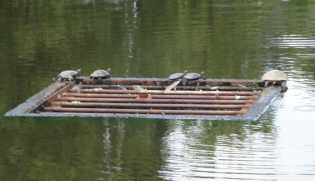
but will bask on any flat surface they can find.

Good pictures are hard to come by, as they are shy around people, and will go underwater at any sudden movement. I happened to catch this rather large and impressive one just as he noticed me and made a break for the safety of deeper water.

I'm as bad a photographer as I am a writer, but I'm learning.
Posted by: Civilis at
04: 08 PM
| Comments (1)
| Add Comment
Post contains 123 words, total size 1 kb.
Monday, June 11 2007
It brings to mind a recent mini-furor that erupted when the Fairfax County public library system announced it was reducing the number of books it has shelved and that many of those removed were under classics. A lot of conservative pundits objected that removing classics from the library was a step on the road of the destruction of American culture, even though it turns out that they're reducing the number books on hand of some of the titles instead of removing particular books entirely, and that they had used an automated formula to pick out books which hadn't been checked out in years.
My question is this: Why do we study English in school? Specifically, what is the primary rationale behind the course curricula of high school English? I know there are a number of reasons English is studied, and that all of them to some degree contribute to the course of study in English classes:
- To teach proper grammar and build vocabulary.
- To teach students to understand the written word, both factual, fictional and poetic, and to write and interpret writing for both style and content.
- To give students an overview of the history of the written word and history as told through the written word, and to provide them with a basic understanding of classic literature which serves as a common cultural root.
- To teach social responsibility and cultural diversity through the written word by exposing students to a diverse body of literature.
- To attempt to teach students to enjoy reading for its own sake, and to foster a love of reading.
Number three, the use of literature to establish a common cultural root, is the "body of academic knowledge" referred to by the quote at top. Although the speaker was referring to all academic disciplines, English allows much more leeway for social engineering than, say, math or science. Likewise, number four is the "government's social goals" alluded to in the quote. Most high school English classes seem to choose works based on some combination of numbers three and four.
Books chosen to satisfy the demands of social multiculturalism (number four) were always my biggest problem in class. They were often incredibly boring, often because they were chosen by a panel of adult English teachers, most female, to satisfy the goals and interests of adult English teachers. For a male high school student, even one that loves reading, they satisfy nothing. Slowing them down to attempt to both address the need to technically understand the written word by learning about the writer's use of stylistic elements (reason number two) and to keep all the class at the same point made them more unbearable.
Books chosen for historical context were sometimes marginally better. We studied Shakespeare because a lot of later works make reference to his works, and it helps to properly understand the context of the original. References to Hamlet, MacBeth, and Romeo and Juliet pop up everywhere. But a lot of the old classics have lost their cultural relativity as time has passed. A lot of modern culture relies on books not covered in high school English. Most high school students that care about reading or would benefit from knowledge of the classics would learn more from Lord of the Rings than The Great Gatsby or The Old Man and the Sea.
The question is: what literature is still culturally relevant today? If you had to do a short list of what English students need to read to get American culture, what would be on it?
My list is as follows: The Illiad, The Odyssey, Romeo and Juliet, Hamlet, MacBeth, Dracula, Frankenstein, 1984, Animal Farm, the Time Machine. Ideally, the list should include at least one of Bradbury's or Asimov's works, plus a Sherlock Holmes story (Hound of the Baskervilles, perhaps?). There are a couple of real classics that would remain second string, such as A Tale of Two Cities, which while I found them to be boring, do serve a useful purpose. About the only poetry on the list is Edgar Allen Poe's the Raven.
You'll notice no further mention of Goal Number Five. That's because, paradoxically, the more effort you put into forcing people to read, the less likely they will be to read for fun.
Posted by: Civilis at
09: 09 PM
| No Comments
| Add Comment
Post contains 821 words, total size 5 kb.
Thursday, June 07 2007
One thing I did want to comment on was the way we distort history even when directly addressing it. The second world war has long been the war that has figured largest in popular culture for a number of reasons: it was a good war fought against the baddest bad guys of history. It was fought with courage, cunning, and gee-whiz technology. It provides cinematic moments of all types all over the world.
And yet, with all that, in fact because of all that, it gets distorted in the lens of culture. It even gets distorted in the eyes of history buffs. There is so much to be fascinated on in the small scale that one loses track of the big picture.
I play a World War 2 historical miniature wargame that involves pushing small models of troops and tanks and guns across a table. The guys who do this sort of thing are all history buffs, many to a degree much greater than I am. If you have an interest in history and a lot of patience, it can be quite fun. But it's both educational and a distortion of history at the same time. Take German armored fighting vehicles for example. The names are often quite familiar to history buffs: Panther, Tiger, Konigstiger, Ferdinand, Elefant, Jagdpanther, Hummel. And those are just the big monsters. You've got a half dozen configurations of the common Panzer III, Panzer IV, and StuG. If you're putting together a German armored force, you've got tons of types of tanks to choose from, all used at one point or another, and all laid out in a hand set of values and formulas for use in the game. What the books don't necessarily say is that some of these models were only produced in limited numbers and saw combat only a handful of times before falling out of the picture entirely. Sure, they're neat vehicles and all, but in fact they're historical curiosities. [American players have it easy. You have a M4 with a 75mm gun or a M4 with a 76mm gun to choose from for most of the war.]
There is just so much ground to cover that if you look at the little picture you often miss how it figures into the big picture. If you look at the big picture, you miss all the little pictures.
Posted by: Civilis at
09: 10 PM
| No Comments
| Add Comment
Post contains 448 words, total size 3 kb.
Wednesday, June 06 2007
To make a long story short, 63 years ago today, nine divisions, 5 American, 3 British and one Canadian (plus smaller units including troops from other nations) landed on the beaches or parachuted into the fields of Normandy, France. Even with some study of history, it is impossible for me to think of what it must have been like to cross those kill zones into Nazi-occupied Europe.
Every day, as I travel down route 29 in northern Virginia on my way to work, I pass a sign designating the highway as the "29th Infantry Division Highway". Until recently, I didn't connect that name with the inexperienced American troops that landed on Omaha beach that morning 63 years ago. I wonder how many other drivers even notice the sign?
Posted by: Civilis at
05: 02 PM
| No Comments
| Add Comment
Post contains 205 words, total size 1 kb.
Monday, June 04 2007
My last post refers to the benefits of the reduced barriers to entry in allowing more people to work at producing content. Today, I read Glenn Reynolds and he links to Lawrence Lessig's critique of Andrew Keen's book, "The Cult of the Amateur". Keen is sharply critical of what I praised in the last post, so we'll have to agree to disagree.
One thing I want to bring up is Keen's disparagement of amateurs as opposed to experts, citing (for example) Wikipedia and the internet in general as examples of amateurs lowering the level of the discourse by publishing unverifiable or even false facts and clouding the debate, and that he prefers the established media with experts for finding the truth.
My complaint is that the media by and large isn't composed in experts in anything except journalism. Certain journalists have enough experience in other specific areas (Middle Eastern politics, sports, etc.) to claim some degree of expertise, but so do those of us in the public at large.
Any time I read a story in the paper about something I have taken an interest in, I can count on finding simplifications, distortions, omissions and outright false information. Journalists are human, just like the rest of us, and its a challenge packaging information for the unique product that is the modern American media. This means that they are not infallible conveyors of information, and pretending that they are only serves to increase the disconnect with consumers of news.
Posted by: Civilis at
08: 11 PM
| Comments (2)
| Add Comment
Post contains 311 words, total size 2 kb.
Sunday, June 03 2007
Yesterday evening, I read a post by Ann Althouse on the amateurization of porn, and immediately thought of the movie. The movie wasn't porn, in any respect at all, but it does reflect the same trend. Right now, a lot of creative content production is being done by amateurs, and to a degree that most people don't realize because we all see a very small section of the whole cultural product that is available to us.
YouTube has enabled producers of video to make their works available to the entire world. Sites like DeviantArt allow artists to make their works available to a wide audience. The initial audience for anime outside of Japan has always been dedicated teams of amateur fans who subtitle works themselves, now aided by the power of the internet. Many PC games have found new life with fan-created content. Many historical wargames started out as home rules created by gamers.
The internet has, of course, been a big enabler of this phenomenon. It allows us to find groups of like-minded people all over the world, and increasingly allows larger and larger groups to work together on bigger and bigger projects. Yet I suspect that it would be happening even without the internet. I remember the days when fan-subbed anime was carried on by nth-generation copied videotapes, not p2p bittorrent filesharing.
more...
Posted by: Civilis at
09: 30 AM
| No Comments
| Add Comment
Post contains 365 words, total size 2 kb.
Tuesday, May 22 2007
Anyways, Ace of Spades HQ posted a list of the proposed Fall TV line-up, and it looks completely horrible. Not that I watch much on TV anyways, but there's no reason for me to even start up again. Every so often, someone tells me about some must-see TV show that's "one of the few things good still on TV" and it's never something that sounds interesting enough to watch.
Here are my conclusions based on my observations on the subject:
1. There is a growing percentage of the American population that is getting disconnected from traditional media such as TV. It's a group that by and large share traits that make them difficult to represent in surveys. How do you accurately survey a group that shares a trait that they don't show up in surveys? You can't, so the trend is going unreported and likely distorting viewership statistics.
2. The growth of this group is fueled by the decisions of TV network executives. TV programming is largely being focus-driven to appeal to the largest groups of TV viewers. Those viewers that do not fall into these groups are left with little to attract them to TV as opposed to other forms of entertainment. Right now, one of the largest groups of TV viewers are reality show fans. So all networks started making reality shows. If you don't like reality shows, there's not much for you to watch. This means that more of the remaining viewers are reality show fans, and the networks have to compete among reality show fans for viewership. Therefore they segment down to the groups within reality show viewers, further distorting the market.
3. Whatever process is used to come up with creative show ideas is failing, so new shows are uninspired. A show written to appeal to the largest possible audience is likely to not appeal to any of its intended viewers. The creative minds are trying to insure success by repeating what was successful in the past, however, this is more often a recipe for failure than success. I also suspect that TV executives that have to approve these shows are not likely fans of any particular genre of TV and hence have to approve shows without much understanding of what actually appeals to most viewers.
4. The practice of canceling mediocre shows, especially mediocre niche shows in genres such such as sci-fi, is further souring fans on future shows. Those few niche shows that get greenlighted are likely to be uncreative, written to appeal to a broad audience (and not actually appealing especially well to anyone), and fans who might otherwise be interested are unlikely to invest time on a show that can be canceled even if it is good.
5. Marketing is subject to the same progressive failure that the creative process is. In order to advertise that a show is out there, the networks invest in commercials and tie-ins. Since most of the shows that are hyped end up being mediocre, viewers distrust the marketing. What do the marketers do? Step up the marketing. So marketing gets less and less effective as time goes on even as more and more effort is expended on it. Word of mouth recommendations would be a way around this, but TV networks have alienated the die-hard fan base by killing shows that had a small but devoted following.
The same problems can be applied to modern movies, with a few additional issues:
6. Movie studios seem to be unable to determine why a movie succeeded. Too often, the success is placed on the star or stars on the top of the marquee. This leads the stars to demand more movies written for them, and more money devoted to hiring the star.
7. Success is determined entirely by box office intake. While, yes, in a market this is a good example of success, it's not a necessarily a good way to determine what the next successful movie will be. Further complicating things is the Hollywood tradition of obfuscating just how much of the money the film made is actually profit. A movie that makes $100 million may be more successful than a movie that only makes $20 million, but if that $100 million movie costs that much to make and the $20 million picture only cost $10 million to make, the picture isn't looking as good.
more...
Posted by: Civilis at
08: 25 PM
| No Comments
| Add Comment
Post contains 793 words, total size 5 kb.
Sunday, May 20 2007
has a secret conservative bias, as some of the liberal letter writers do their own cause more harm than good.
Case in point: a letter from Joan Salemi that appeared in today's Outlook section. She calls into question a recent columnists' argument that Tony Blair was a better leader than Chirac, as Blair used his power to benefit the world while Chirac used his power to benefit France. It's a short letter, but the relevant passage is here:
Uh, hello? France with Chirac at the helm certainly had no problems acting unilaterally to intervene in other parts of the world. Chirac has emerged as a reliable ally for dictators around the world. Although, ironically, she may be right about one thing... if Chirac had been president on September 11th, we probably wouldn't have invaded Iraq, though I don't know if his favored approach would be viewed by Ms. Salemi as being any better.
more...
Posted by: Civilis at
08: 38 PM
| No Comments
| Add Comment
Post contains 1014 words, total size 7 kb.
Thursday, May 17 2007
I tend to think all the time, but without a catalyst for my thoughts to build around, the resulting output is rambling and incoherent. Okay, it's more rambling and incoherent than usual. I like to write, and I need to learn to put my thoughts on paper.
Posted by: Civilis at
07: 35 PM
| Comments (1)
| Add Comment
Post contains 91 words, total size 1 kb.
43 queries taking 0.1106 seconds, 148 records returned.
Powered by Minx 1.1.6c-pink.









